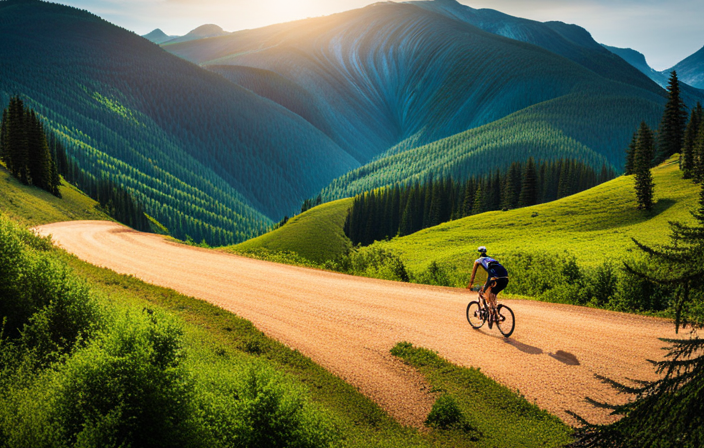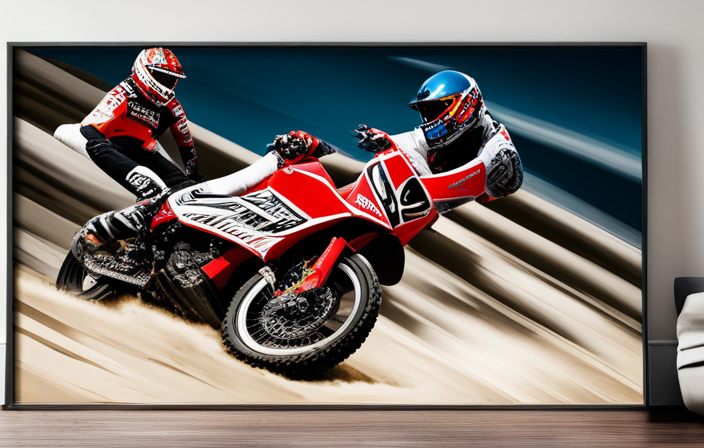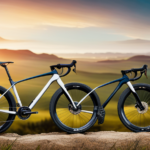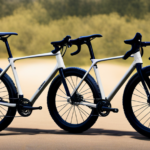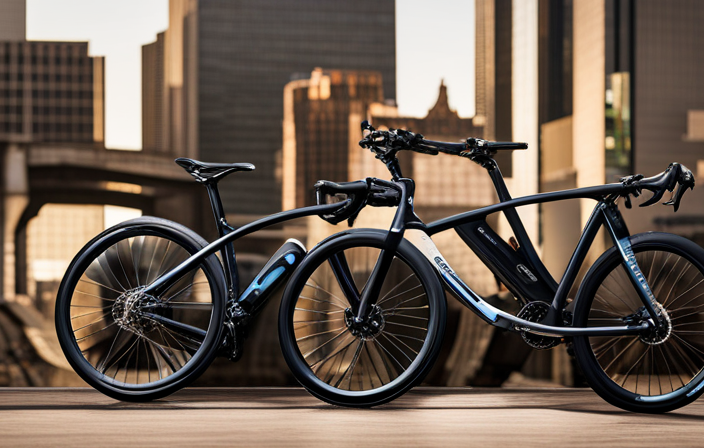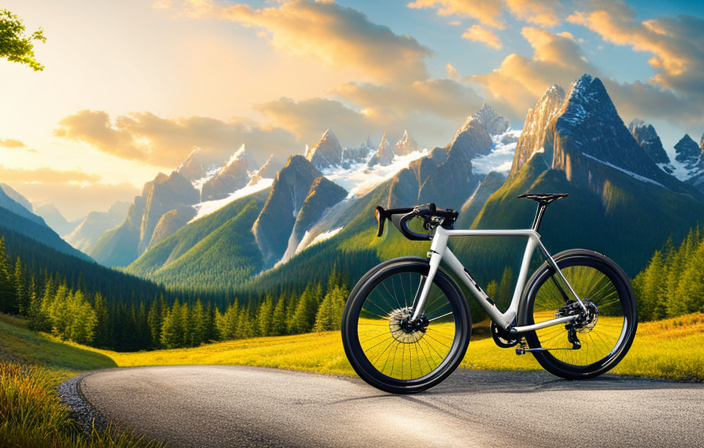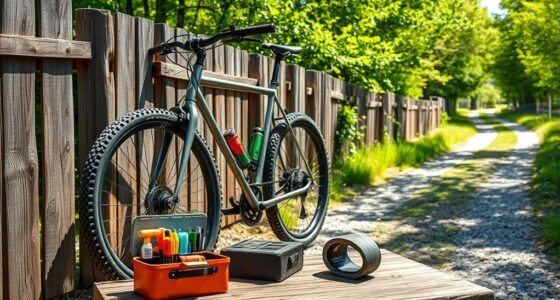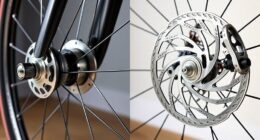Are you fed up with the usual bike routes? Searching for a new adventure that merges the excitement of off-road biking with the discovery of breathtaking landscapes?
Well, let me introduce you to a hidden gem in the world of biking: gravel loops. These unique routes offer an exhilarating experience, taking you off the beaten path and onto gravel roads less traveled.
In this article, we’ll delve into what exactly gravel loops are and why they’re becoming increasingly popular among cyclists everywhere.
So buckle up, grab your bike, and get ready to discover a whole new world of two-wheeled excitement!
Key Takeaways
- Gravel loops are popular among cyclists for exploring new routes and challenging themselves.
- Gravel loops offer an alternative to traditional road rides by taking riders off the beaten path.
- Riding on gravel increases strength, endurance, and cardiovascular fitness.
- A sturdy and reliable gravel bike is essential for handling rough surfaces.
Introduction to Gravel Loops in Bike Rides
Gravel loops are a popular choice for cyclists looking to explore new routes and challenge themselves on unpaved terrain. These unique cycling routes offer an exciting alternative to traditional road rides by taking riders off the beaten path and onto gravel roads or trails. Gravel loop routes can vary in length and difficulty, providing options for cyclists of all skill levels.
One of the main attractions of gravel loops is the challenge they present. Riding on unpaved surfaces requires a different set of skills compared to road cycling. Cyclists must navigate through loose gravel, dirt, and sometimes even mud, which demands greater control and balance. The varying terrain also adds an element of unpredictability to the ride, keeping cyclists engaged and alert throughout.
In addition to the physical challenges, gravel loops also provide scenic beauty that may be missed on paved roads. These routes often take riders through picturesque landscapes like forests, farmlands, or mountainsides. The peacefulness of these natural surroundings can be incredibly refreshing and rejuvenating.
Moreover, gravel loops offer a sense of adventure and exploration as riders venture into lesser-known areas that are not typically frequented by cars or pedestrians. This allows cyclists to discover hidden gems along the way – from quaint small towns to breathtaking viewpoints.
By incorporating gravel loops into their rides, cyclists can not only enhance their skills but also experience the numerous benefits these routes have to offer – from challenging terrains to stunning scenery and unforgettable adventures.
Benefits of Gravel Loops
One of the advantages of these routes is that they offer a variety of terrain. Gravel loops in bike rides provide an exciting and challenging training ground for cyclists. Whether you are preparing for a gravel loop event or just looking to improve your skills, these routes have numerous benefits. Here are four reasons why gravel loops can take your cycling experience to the next level:
-
Terrain diversity: Gravel loops allow you to encounter different types of terrain, from smooth gravel roads to rugged trails. This variety keeps your rides interesting and helps develop your ability to handle various surfaces.
-
Increased strength and endurance: Riding on gravel requires more effort than on paved roads, as it demands greater stability and power output. Regularly tackling gravel loops will help build your leg muscles, improve cardiovascular fitness, and enhance overall endurance.
-
Technical skills improvement: Navigating unpaved surfaces enhances your bike handling skills, such as balance, cornering, and braking techniques. These skills are invaluable not only during gravel loop events but also in other off-road cycling adventures.
-
Mental resilience: Conquering challenging terrains on gravel loops builds mental toughness by pushing you outside your comfort zone. It teaches you to stay focused, adapt quickly to changing conditions, and overcome obstacles.
Transitioning into the subsequent section about essential gear for gravel loops allows cyclists to fully enjoy these benefits without any setbacks or discomforts during their rides.
Essential Gear for Gravel Loops
To fully enjoy your cycling experience on challenging terrains, make sure you have the essential gear for tackling gravel loops.
Gravel riding requires specific equipment to ensure a safe and comfortable journey. First and foremost, a sturdy and reliable gravel bike is essential. These bikes are designed with wider tires, stronger frames, and more stable geometry to handle rough surfaces.
Additionally, investing in quality bike accessories can greatly enhance your ride. A good pair of cycling shoes with grippy soles will provide better traction when navigating loose gravel sections. Padded gloves will offer comfort and protect your hands during long rides. It’s also important to have a helmet that fits properly and provides adequate protection.
Other useful accessories include a hydration pack or water bottles, a multi-tool for any necessary repairs along the way, lights for visibility during low-light conditions, and a saddlebag to carry spare tubes or tools.
Now that you have all the necessary gear for your gravel adventure, it’s time to start planning your route!
Planning Your Gravel Loop Adventure
When planning my gravel loop adventure, I always start by researching and mapping out routes. This allows me to find the best paths that suit my preferences and avoid any potential roadblocks or hazards.
Next, I consider the distance and difficulty levels of each route, ensuring that it aligns with my fitness level and time constraints.
Lastly, I make sure to identify water and rest stops along the way to stay hydrated and refuel during the ride.
By taking these steps, I can ensure a smooth and enjoyable gravel loop adventure.
Researching and Mapping Out Routes
Start by researching and mapping out routes for your bike rides to find the perfect gravel loops. Here are four key things to consider during this process:
-
Local Knowledge: Tap into the knowledge of local cyclists or bike shops who can provide insights on popular gravel routes in the area. They may have hidden gems that are not easily found online.
-
Online Resources: Utilize websites and apps dedicated to cycling, like Strava or Ride with GPS, which offer user-generated route suggestions and detailed maps with elevation profiles.
-
Mapping Techniques: Experiment with different mapping techniques, such as using paper maps, GPS devices, or smartphone apps, to plan and navigate your routes effectively.
-
Safety Considerations: Take note of road conditions, traffic volume, availability of water sources, and places to rest along the way to ensure a safe and enjoyable ride.
Once you have researched and mapped out potential routes, it’s time to consider distance and difficulty levels in order to tailor your gravel loop adventure accordingly.
Considering Distance and Difficulty Levels
Considering the distance and difficulty levels is crucial when planning your gravel loop adventure.
The distance of your ride will determine how long you’ll be on the bike, so it’s important to choose a distance that matches your fitness level and time availability. If you’re a beginner, starting with shorter distances is recommended to build up endurance gradually. On the other hand, experienced riders might prefer longer distances for a more challenging and rewarding experience.
Difficulty levels are also important to consider as they can vary depending on factors such as elevation gain, terrain type, and road conditions. Choosing a route that aligns with your skill level will ensure an enjoyable ride without pushing yourself too hard.
Now that we’ve determined the distance and difficulty levels, let’s move on to identifying water and rest stops along the way for a well-prepared journey ahead.
Identifying Water and Rest Stops Along the Way
Identifying water and rest stops along the way is essential for a well-prepared journey. When embarking on gravel loops, it’s important to plan ahead and know where you can refuel and take breaks. Not only will this ensure you stay hydrated and energized, but it will also allow you to appreciate the scenic routes that these rides often offer.
To emphasize the significance of planning, here is a table showcasing some popular gravel loop routes and their corresponding water and rest stop locations:
| Gravel Loop Route | Water Stop Location | Rest Stop Location |
|---|---|---|
| Loop A | Mile 10 | Mile 20 |
| Loop B | Mile 5 | Mile 15 |
| Loop C | Mile 8 | Mile 16 |
In addition to identifying these stops, it’s crucial to choose appropriate bike tires that can handle the demands of gravel terrain. This ensures a smoother ride and reduces the risk of flats or accidents.
By understanding how to identify water and rest stops as well as choosing suitable bike tires, your gravel loop adventure will be both enjoyable and safe. Transitioning into the subsequent section about riding techniques for gravel loops allows us to delve further into mastering this exhilarating style of cycling.
Riding Techniques for Gravel Loops
There’s no denying that riding techniques for gravel loops require a different set of skills than road cycling. Gravel riding involves navigating uneven terrain and loose surfaces, so having the right bike handling techniques is crucial for a smooth and enjoyable ride.
Here are three key riding techniques to keep in mind:
-
Weight distribution: When riding on gravel, it’s important to distribute your weight evenly between the front and rear wheels. This helps maintain traction and stability, especially when going over bumps or through corners.
-
Line choice: Unlike road cycling where you can stick to a narrow line, gravel riding allows for more freedom in choosing your path. Look ahead and pick the smoothest line possible, avoiding large rocks or deep ruts that could cause you to lose control.
-
Relaxed grip: Maintaining a relaxed grip on the handlebars will help absorb vibrations and allow your bike to move more freely beneath you. It also enables better control when steering through rough sections.
Mastering these riding techniques will greatly enhance your experience on gravel loops.
As we shift our focus to safety precautions for gravel loops, it’s important to remember that these techniques go hand in hand with staying safe while enjoying your ride.
Safety Precautions for Gravel Loops
To ensure your safety while riding on uneven terrain, it’s essential to take certain precautions. Gravel loops can be exhilarating and challenging, but they also pose unique risks. Safe riding starts with being prepared for any situation that may arise.
First and foremost, always wear a well-fitting helmet to protect your head in case of a fall or collision. Additionally, make sure your bike is in good condition with properly inflated tires and functioning brakes.
Emergency preparedness is another crucial aspect of safe gravel loop riding. Carry a basic first aid kit that includes bandages, antiseptic wipes, and pain relievers in case of minor injuries. It’s also wise to bring along tools such as tire levers and a puncture repair kit for quick fixes on the go.
Being aware of your surroundings is vital when riding on gravel loops. Keep an eye out for loose gravel, potholes, or other obstacles that could cause you to lose control of your bike. Maintain a safe speed that allows you to react quickly if needed.
Transitioning into nutrition and hydration tips for gravel loops: Alongside ensuring your safety, it’s equally important to adequately fuel yourself during these rides to maintain energy levels throughout the journey without compromising performance.
Nutrition and Hydration Tips for Gravel Loops
When riding on uneven terrain, it’s important to prioritize proper nutrition and hydration for optimal performance during your journey. Gravel loops can be physically demanding, so fueling your body with the right nutrients is crucial.
Start by consuming a balanced meal or snack before your ride, including carbohydrates for energy and protein to support muscle repair. During the ride, it’s essential to stay hydrated by drinking water regularly. Consider carrying a water bottle or hydration pack to ensure you have access to fluids at all times.
In terms of nutrition tips, aim to consume small, frequent meals or snacks throughout the ride rather than one large meal. This will help maintain energy levels and prevent stomach discomfort. Pack portable and easy-to-eat snacks such as energy bars, bananas, or trail mix that provide a mix of carbohydrates, protein, and healthy fats.
Hydration strategies are equally important during gravel loops. Along with water, consider electrolyte-rich drinks or sports drinks to replenish lost minerals through sweat. Electrolytes play a vital role in maintaining fluid balance and preventing dehydration.
Moving on from nutrition and hydration tips for gravel loops, let’s discuss maintenance and bike care after completing your adventurous ride without compromising safety measures.
Maintenance and Bike Care After Gravel Loops
After completing a challenging gravel loop, it’s important to give your bike some love and care.
Start by cleaning and lubricating your bike to ensure optimal performance.
Next, check for any wear and tear on your tires and components, as this can affect the safety and efficiency of your ride.
Lastly, don’t forget to schedule regular inspections and tune-ups to keep your bike in top shape.
By following these steps, you’ll be ready for more thrilling gravel adventures!
Cleaning and Lubricating Your Bike
Cleaning and lubricating your bike is essential for maintaining its performance.
When it comes to cleaning techniques, start by using a bucket of warm soapy water and a sponge or soft brush to gently scrub away any dirt or grime. Pay special attention to hard-to-reach areas like the chain, cassette, and derailleur. Rinse off the soap with clean water and dry the bike thoroughly with a towel.
Once clean, it’s important to choose the right lubricant for your bike. Look for one specifically designed for bicycles and apply it to the chain, derailleurs, and other moving parts. This will help reduce friction and keep everything running smoothly.
With a well-cleaned and properly lubricated bike, you can now move on to checking for wear and tear on tires and components in order to ensure a safe ride without any unexpected issues arising.
Checking for Wear and Tear on Tires and Components
To ensure a safe ride, it’s important to regularly check for wear and tear on the tires and components of your bicycle. When it comes to tire maintenance, start by examining the tread depth. A good rule of thumb is that if the tread depth is less than 1/8 inch, it’s time to replace the tire. Additionally, inspect the sidewalls for any cracks or bulges, as these can indicate a weakened tire that is more prone to blowouts.
Moving on to component inspection, give your brakes a thorough once-over. Check if they are functioning properly and have enough brake pad material remaining. Next, inspect the chain for any signs of rust or stretching. Finally, examine all other components such as gears, pedals, and handlebars for any looseness or damage.
Regular inspections and tune-ups will help keep your bike in top shape for many rides to come.
NEXT SUBTOPIC: ‘Regular Inspections and Tune-ups’
Regular Inspections and Tune-Ups
Regular inspections and tune-ups are essential for maintaining the optimal performance and safety of your bicycle. Regular maintenance is key to preventing major issues from occurring, as it allows you to identify and address any potential problems before they worsen.
During inspections, I thoroughly check all components of my bike, including the brakes, gears, chain, and tires. This helps me troubleshoot any issues that may be affecting the overall performance of my ride. By tightening loose bolts, adjusting brakes, and lubricating moving parts, I ensure that my bike is in top condition for every ride.
Taking the time to perform these regular tune-ups not only keeps me safe on the road but also enhances my riding experience. Transitioning into connecting with the gravel loop community, it’s important to have a well-maintained bike when exploring new routes alongside fellow riders.
Connecting with the Gravel Loop Community
Want to connect with the gravel loop community? Here are four ways to get involved and join the vibrant and supportive network of gravel cyclists:
-
Attend gravel loop events: Look for local races, group rides, or organized events that focus on gravel riding. These gatherings provide an excellent opportunity to meet fellow riders, swap stories, and learn from experienced cyclists.
-
Join gravel loop clubs: Many regions have dedicated gravel cycling clubs where like-minded individuals gather to share their love for off-road adventures. Being part of a club not only gives you access to group rides but also connects you with knowledgeable riders who can offer advice on routes, gear, and training.
-
Engage on social media platforms: Social media platforms like Facebook groups or Instagram hashtags are great places to find other gravel enthusiasts. Connect with them, ask questions, share your experiences, and get inspired by their photos and stories.
-
Volunteer at events: Consider volunteering at gravel loop races or events in your area. This not only helps support the community but also allows you to interact with riders and organizers more closely.
Now that you’re plugged into the community, let’s delve into exploring some exciting gravel loop destinations without delay!
Exploring Gravel Loop Destinations
Ready to embark on an adventure? Let’s discover some incredible destinations for exploring the world of gravel cycling! Gravel loop routes offer a unique and thrilling experience for cyclists looking to get off the beaten path. Whether you’re a seasoned rider or new to gravel cycling, these destinations are sure to impress.
One popular gravel loop destination is Moab, Utah. With its stunning red rock landscapes and diverse terrain, Moab offers a wide range of gravel routes for all skill levels. From the famous Slickrock Trail to the challenging Porcupine Rim Loop, there’s something for everyone in Moab.
Another great destination is Bend, Oregon. Known for its picturesque scenery and abundance of outdoor activities, Bend has become a mecca for gravel cyclists. The area boasts numerous gravel loop routes that wind through forests, past lakes, and along scenic mountain vistas.
When planning your gravel loop adventure, it’s important to consider the best time to ride these routes. Generally, spring and fall offer ideal weather conditions with cooler temperatures and less precipitation. However, each destination may have its own unique climate considerations, so be sure to do your research before hitting the trails.
So grab your bike and get ready to explore these amazing gravel loop destinations. With their breathtaking scenery and challenging terrain, you’re sure to have an unforgettable experience in the world of gravel cycling!
Frequently Asked Questions
Are gravel loops suitable for beginners or only experienced cyclists?
Gravel loops can be suitable for beginners, but there are pros and cons to consider.
On the positive side, gravel riding offers a fun and adventurous experience, with scenic routes and less traffic. However, it requires different skills and preparation compared to road cycling.
To prepare for your first gravel loop ride, start by choosing a suitable bike with wider tires. Practice on similar terrain and learn how to handle loose surfaces. Always carry essential tools for potential flat tires or mechanical issues.
How can I find gravel loop routes in my area?
Finding gravel loop routes in my area is like embarking on a thrilling treasure hunt.
Not only do these routes offer a refreshing change from regular road cycling, but they also bring a host of benefits to your biking experience.
Gravel loops provide an exciting challenge, allowing you to test your skills and improve your bike handling.
Additionally, they offer breathtaking scenery and a sense of adventure as you explore off-the-beaten-path trails.
To find such routes, I recommend checking local cycling clubs, online forums, or using GPS apps tailored for cyclists.
Happy hunting!
What is the best type of bike to use for gravel loops?
The best type of bike for gravel loops is a gravel bike. These bikes are designed specifically for riding on gravel roads and trails. They have features like wider tires, more clearance for mud and debris, and a more relaxed geometry for comfort during long rides.
Gravel bikes also come equipped with the best gravel tires. These tires have a tread pattern that provides excellent traction on loose surfaces. This is important for maintaining control and stability while riding on gravel.
Furthermore, many areas host gravel loop events where riders can test their skills and enjoy the challenge of these unique routes. These events are a great opportunity for gravel bike enthusiasts to come together and experience the thrill of riding on gravel loops.
In conclusion, if you enjoy riding on gravel roads and trails, a gravel bike is the ideal choice. Its specific design features and specialized tires make it the perfect companion for gravel loops. So, get out there and explore the world of gravel riding!
Are there any specific skills or techniques I need to learn for riding on gravel?
When it comes to gravel riding techniques, there are a few important skills to master.
First, maintaining balance on gravel surfaces requires a relaxed grip on the handlebars and slightly bent elbows for better stability.
Secondly, it’s crucial to anticipate changes in terrain and adjust your body position accordingly.
Keeping a steady cadence and avoiding sudden braking or steering movements can also help you stay in control.
With practice and experience, you’ll become more confident and comfortable riding on gravel.
What are some common challenges or obstacles I may encounter on a gravel loop?
Common challenges on gravel loops include loose and unpredictable terrain, which can make it difficult to maintain balance and control. Additionally, gravel surfaces often have more resistance than pavement, requiring extra effort to pedal.
To prepare for riding on gravel, it is important to practice bike handling skills, such as maintaining a relaxed grip and using your body weight to steer. It is also recommended to use wider tires with lower tire pressure for better traction and stability.
Conclusion
In conclusion, gravel loops are an incredible way to experience the thrill of biking while immersing yourself in nature. The benefits of riding on gravel include improved fitness, enhanced mental well-being, and a sense of adventure.
Did you know that according to a recent survey, 85% of cyclists reported feeling more connected with nature after completing a gravel loop? This statistic highlights the profound impact these rides can have on our connection with the great outdoors.
So grab your gear, plan your adventure, and join the thriving community of gravel loop enthusiasts today! Happy riding!
